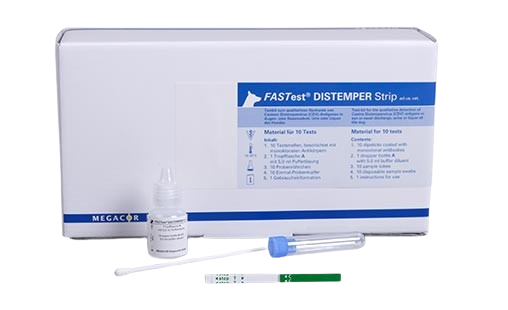Description
For The Detection Of Canine Distemper Virus
Test applicable to: Dog
Sample: Nasal/Ocular Discharge
FASTest DISTEMPER strip is a rapid immunochromatographic test for the detection of Canine Distemper Virus antigen in nasal and ocular discharge from infected dogs and other susceptible species. It is a highly contagious viral illness with no known cure to date. As well as domestic dogs, Distemper can affect certain species of wildlife including raccoons, wolves, foxes and skunks.
What Causes Canine Distemper Virus?
Canine distemper is caused by a paramyxovirus that is highly contagious. Distemper should be considered in the diagnosis of any febrile condition in puppies with multisystemic manifestations. While the typical clinical case is not difficult to diagnose, the characteristic signs sometimes fail to appear until late in the disease. The degree of viraemia and extent of spread of the virus to various tissues is moderate judged by the level of specific humoral immunity in the host during the viraemic period.
FASTest DISTEMPER Strip is a sensitive, reliable and specific immunochromatographic assay designed to detect canine distemper virus antigen in nasal and ocular discharge.
FASTest Distemper Product Information – PDF Download
You may also be interested in FASTest CDV Ab, follow this link
Why Test?
Why is it important to test for Canine Distemper Virus?
Distemper is a disease which is spread through the air and through direct or indirect contact with an infected animal or the animal’s habitat. The disease attacks the dog’s tonsils and lymph nodes for approximately a week and then it will attack the respiratory, urogenital, gastrointestinal and nervous system of the dog. Any dog which is not immunised who comes into contact with an infected animal will run the risk of contracting the disease.
Symptoms
What are the Symptoms of Canine Distemper Virus?
The clinical symptoms commonly associated with Canine Distemper are normal dependant on at the stage of the disease. Initially, the major symptoms are high fevers, reddened eyes which are also runny along with nasal discharge. Any dog which has become infected may also be lethargic and tired and may become anorexic. Vomiting and diarrhoea is often a symptom of the early stages of the disease in infected dogs along with a persistent cough.
In the later stages of the disease, the virus will start to attack the dogs other systems especially the nervous system. Hyperkeratosis of the footpads (“hardpad” disease) and epithelium of the nasal plane may be seen, the dog’s brain and spinal cord are also affected and this may result in fits and seizures, paralysis and attacks of hysteria.
Instructions For Use
Instructions For Use
FASTest DISTEMPER Instructions For Use


